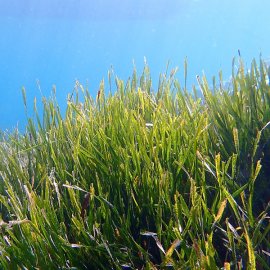Seagrass in Tampa Bay
-
English
-
ListenPause
[intro music]
Welcome to World Ocean Radio…
I’m Peter Neill, Director of the World Ocean Observatory.
During the second half of the 20th century, coasts and bays in the United States and around the world became a turgid dumping ground for urban, industrial, and agricultural waste. The expansion of population, economic growth, tourism, dredging, and nitrogen-based fertilizers created a set of conditions in which life, both marine and human, could not thrive. Dead zones became the norm, at the mouths of rivers and where watershed meet the sea and in large embayments such as the Chesapeake and Tampa Bays where these circumstances concentrated without the diluting effect of open ocean circulation and cleansing rendering the waters impenetrable and poisonous.
One sign of this destruction could be measured in the collapse of sea grasses in the estuaries that provided safety and nutrition no longer available, no longer adequate to a sustainable environment. In the 1970s, with the creation of the US Environmental Protection Agency and passage of the Clean Air and Clean Water Acts, the tools became available to address these critical situations that could be used to generate local action, new research, science, and policy, and political will to counter the indifference or ignorance that characterized the polluting practices and to initiate change.
Tampa Bay in Florida has become over the intervening years the most visible success of such response, transforming the 400 square miles and associated rivers and creeks into clean environments characterized by clear water, better fishing, lack of harmful algae and chemicals, and renewed recreational access. The revival of the sea grass has again been the measure, this time of astonishing success. Aerial views of the bay showed more than half of the sea grass had been killed; today, more than 38,000 acres of grassland have been restored, by nitrogen reduction, upgraded sewage and waste treatment, cleaner energy technology, and voluntary engagement. Initial restoration goals have been met, and exceeded, but the population has continued to grow by over 1 million new residents in the interval. A nd development continues.
This process was enabled by several determined leaders and organizations – the EPA Tampa Bay Estuary Program, Tampa Bay Watch, local environmental organizations, utilities, surrounding municipal governments, state agencies, and community, business, and political leaders – who found common interest, adequate funds, and political will to what needed to be done.
What can we learn from this success?
We can learn that solutions to complex questions require complex information, organization, and social dynamics to succeed. No single entity solved the Tampa Bay problem; it required a public and private catalyst to recognize and finance a response, and it required an often difficult, continuing conversation among all parties to define and execute the strategy.
Second, we can learn that such conversations require time, continuity, engagement, and incremental successes to demonstrate possibility and benefit. Overall consensus might not be immediately achievable, but step-by-step involvement, exemplary partnerships, and realized short-term goals prove that progress can be made and real value returned.
Third, we can learn that leadership and determination remain the best ways to get things done. The bureaucrats, scientists, and conservationists who came together to make things happen in Tampa Bay were real people with good intentions, just like you and me, who saw a problem and came together to fix it.
And fourth, we can learn that if we can solve this one problem then we can also solve others, by duplicating what happened in Tampa Bay, learning from it, applying that experience to different challenges, demonstrating comparable spirit, and generating powerful and positive outcome for the benefit of us all.
These lessons are a primer for optimistic engagement in meeting challenges and solving problems. So, let’s pick one where we live and let’s get started.
We will discuss these issues, and more, in future editions of World Ocean Radio.
This summer we are revisiting some of our favorite World Ocean Radio episodes that highlight optimism in ocean news, science and advocacy. World Ocean Radio has produced more than 650 episodes to date. We are grateful to the staff, volunteers and supporters of WERU-FM 98.9 in Blue Hill, Maine, for broadcasting the first World Ocean Radio episode more than 10 years ago, and continuing to run episodes each week without interruption since. Find us wherever you listen to podcasts, and at World Ocean Observatory dot org.
[outro music]
This summer we are revisiting some of our favorite World Ocean Radio episodes that highlight optimism in ocean news, science and advocacy. In this episode we're discussing Tampa Bay, Florida, whose revival of seagrass and cleaner waters have served as an example of engagement, cooperation, determination, and leadership. What can be learned from this success in order to meet environmental challenges and solve today’s problems?
About World Ocean Radio
World Ocean Radio provides coverage of a broad spectrum of ocean issues from science and education to advocacy and exemplary projects; it is a weekly series of five-minute audio essays available for syndicated use at no cost by college and community radio stations worldwide.
Image Credit
Frédéric Ducarme
Wikimedia Commons
- Login to post comments



